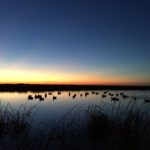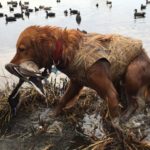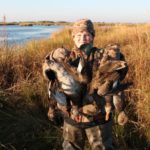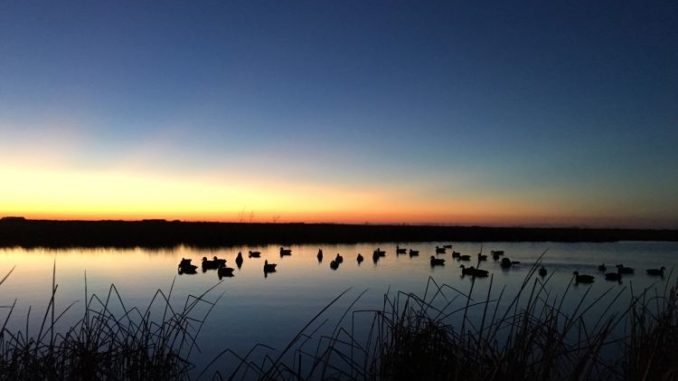
Louisiana has a long reputation as a waterfowling mecca, but that doesn’t mean you have to belong to a high-dollar club. Find out why these five WMAs could be your ticket to heavy straps.
Backlit faintly by the early morning glow, they came as we’d hoped. Silhouettes — large and deliberate, and small and acrobatic — bombarded our spread.
We were able to pick up our jaws from the marsh mud just in time to catch that telltale sound as a few feathered bodies splashed down amongst their plastic counterparts.
“This is what heaven must look like,” we thought to ourselves.
Our crew had observed birds in this area the day before, and it was looking mighty promising that our scout mission was about to pay dividends.
As the last few minutes before legal shooting time crawled by, we marvelled not only at the flights before us but also the lack of other hunters in our general area.
And, though it sounds too good to be true, this seemingly fairy tale setting can be had on the vast offerings of our state’s public lands.
Spanning from the farthest reaches in just about any direction and scattered generously in between, Louisiana’s public waterfowl hunting areas are as numerous as they are diverse.
Want to hunt mallards in standing timber? Can do; head north!
Want to try your hand at specklebelly geese in managed fields? There’s a place for that in the heart of Cajun Country.
Want to shoot canvasbacks and redheads on the edge of the Gulf of Mexico? You’ve actually got multiple option.
Whether accessed by boat, ATV or your feet, quality public offerings abound to the tune of more than 1.5 million acres.
Location is commonly king, but waterfowl won’t stick around without a nearby buffet. So here are five areas that deliver the goods to the birds and tend to consistently reward those hunters willing to learn the keys of each.
1. Richard K. Yancey WMA — Concordia Parish
Situated approximately 35 miles south of Ferriday, this sprawling management area offers hunters nearly 70,000 acres of prime waterfowl habitat situated between the Red and Mississippi Rivers.
According to LDWF’s Tony Vidrine, it’s the immensity and variety that makes this WMA an ideal stopover for birds and a great destination for hunters.
“It’s got a lot of acreage, so that helps us to hold birds, especially since its right here in the Three Rivers area,” Vidrine said, alluding to the confluence of the Mississippi, Red and Atchafalaya rivers. “This helps to funnel birds from smaller flyways within our state into this area.”
Featuring moist soil units, green tree reservoirs, swamps and lakes, this unit’s variety gives waterfowl a little bit of everything.
Thankfully, access is afforded to hunters via ATV trails, as well by boat.
Vidrine also noted that some of the areas are walk-in accessible, so Richard K. Yancey WMA offers access to just about anyone.
And though Vidrine added that it can see its share of pressure when word gets out, the sheer size of the WMA and variety of habitat helps spread hunters out and mitigate overcrowding.
Typical species harvested include wood ducks, mallards, green wing teal and gadwall.
2. Atchafalaya Delta WMA — St. Mary Parish
As the name implies, this sprawling unit of more than 137,000 acres includes the mouths of both the Atchafalaya River and the Wax Lake Outlet where they meet the Gulf of Mexico.
LDWF’s Lance Campbell said the dynamic nature of these waterways makes it the place to be for a migrating duck.
“This area has a lot of different habitat types and food — basically everything a duck needs in one place,” Campbell said. “The deltas are constantly changing and creating new habitats of varying water depth.
“It’s like the perfect storm of ideal factors.”
It’s this diversity of water depth, Campbell said, that affords arriving ducks a number of options for feeding and loafing areas.
“The different depths tend to attract a myriad of ducks, with species like canvasbacks, scaup and redheads taking to the deeper water, and puddlers like teal, pintail, gadwall and mallards dabbling in the shallow flats,” Campbell said. “It’s truly a unique area in that a hunter can bag a wide variety of species from the same blind.”
This WMA also features a limited access area (LAA), in which the use of internal combustion engines is prohibited. That typically means less hunting pressure than the rest of the unit. As a result, some hunters in the LAA often fare better than those hunting the main unit.
Regardless of the area chosen, Atchafalaya Delta hunters contribute their share to the state’s annual harvest year after year.
Access to this wonderland is via boat via Calumet Cut or the Atchafalaya River.
3. Pass a Loutre WMA — Plaquemines Parish
Situated at the mouth of the Mississippi River and the literal end of the road for the Mississippi Flyway, year-to-year production on Pass a Loutre is perhaps the worst-kept secret of our state’s waterfowling heritage.
And though some might argue the good old days are long past, don’t tell the throngs of birds that continue to spend much of the winter enjoying the primo habitat the WMA’s 115,000 acres of passes and flats afford.
Best of all, pressure tends to be on the lighter side, according to LDWF’s Shane Granier.
“It can be a challenge to access when dealing with the Mississippi River, but most find it worth the trouble,” Granier reported.
Considering the amount of hype this destination gets, most would assume it’s overrun with hunters — but that’s just not the case.
“It is one of the least-hunted units of our better WMA’s,” Granier said.
Each year, ducks and even a fair number of snow geese make their way to the end of the flyway and the buffet that waits at the mouth of the Mighty Mississippi.
“The birds tend to key in on stands of duck potato, along with a myriad of submerged vegetation found throughout the area,” Granier said. “Each year, the high river levels rejuvenate this area, making new habitat (and) thus setting the table for the migration to follow.”
Pass a Loutre also features approximately 1,800 acres dedicated as an LAA surrounding Johnson Pass. With no motorized boats allowed, this area typically receives even less pressure than the main WMA while being just as productive — maybe even more so.
The LDWF also maintains primitive camp sites for those who don’t mind roughing it to stay on the birds for a few days at a time.
Although the area winters just about every type of duck that wings through the famed Mississippi Flyway, it’s perhaps best known for its numbers of pintails and canvasbacks, with some hunters traveling great distances for such promising chances at these majestic species.
4. Biloxi WMA — St. Bernard Parish
Southeast Louisiana hunters continue to hang their hats on their beloved gadwall, better known as “gray duck” to most in the region.
And there are few better options for pursuing these birds than this WMA located in St. Bernard Parish’s Biloxi Marsh.
Readily accessed via boat from a variety of ports, Biloxi WMAl consists of almost 43,000 acres of nearly exclusively open salt marsh, complete with a maze of lagoons and small canals.
The shallows of this marsh system tend to support vast acreages of wigeon grass that attract hordes of gadwall year after year.
“This WMA offers fairly easy access from either Shell Beach or Hopedale, but also from Mississippi ports via Lake Borgne,” Granier said. “Best of all, it can be accessed by large boats or small, so it affords hunting opportunity to a lot of people who may not have a specialized hunting boat.”
Granier also pointed out the recent change in policy that restricts hunters using air-cooled motors to 25 horsepower or less — and only in the long-tail style of propeller shaft.
There continues to be no restriction on the use of outboards, however.
In addition to gadwall, hunters in the area commonly harvest blue- and green-winged teal, wigeon and shovelers, as well as divers like scaup, buffleheads and redheads in locations nearer the shores of Lake Borgne.
5. Point-aux-Chenes WMA — Terrebonne & Lafourche parishes
Commonly referred to as “PAC,” this WMA spans two parishes and approximately 35,000 acres situated just southeast of Houma.
Granier said this unit is popular with residents of the two parishes and beyond — for good reason.
“This area offers hunters easy access to a lot of unique (and productive) habitat,” the biologist said.
In fact, this WMA might be one of the easiest in the region to access, considering so many areas require lengthy boat rides to get in on the action.
While boats might afford access to more-distant portions of the area, the WMA also features a network of roads for easy deployment of kayaks or pirogues, thus offering significant hunt opportunity for those without boats.
“We operate a large marsh management system where we control the water levels year round,” Granier said.
In doing so, habitats are managed for optimum growth of such foods as wigeon grass that helps hold birds once they’ve arrived.
“With our water management, we’re able to hold out surges of saltwater and also hold water in when the north winds of winter leave surrounding areas in mud flats,” Granier said.
This allows consistent accessibility for hunters regardless of tidal conditions when the big fronts blow through and also draws ducks otherwise left with mud flats elsewhere.
This WMA also features a roughly 4,700-acre LAA, with LDWF bag checks indicating respectable bags coming from the motor-free unit over the last five seasons.
Like many other areas of the region, blue and green winged teal along with gadwall lead the harvest in this WMA.
Top tactics for public waterfowling success
With so many quality options for chasing waterfowl on the Bayou State’s public land, most hunters usually find a few birds for the pot.
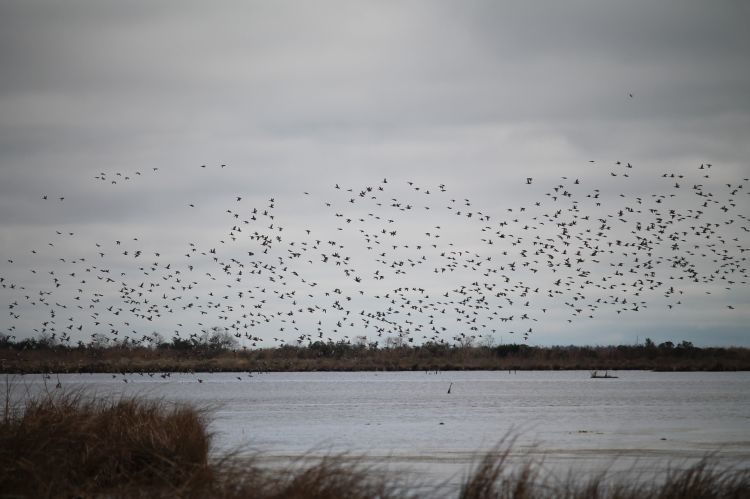 However, those looking to do it with consistency should heed the recommendations of LDWF’s Lance Campbell:
However, those looking to do it with consistency should heed the recommendations of LDWF’s Lance Campbell:
- Sufficient scouting prior to hunting is critical. Campbell also recommends minimizing disturbance of resting or feeding waterfowl while scouting to help keep birds in the area and increase the odds you’ll find them there on your next hunt. Binoculars are your friend.
- Become familiar with and regularly utilize more than one hunting site. Getting to know more than one WMA and more than one unit of a WMA will help increase the odds of finding a few targets as conditions and pressure move birds around.
- Be flexible and willing to learn new tactics and setup types. Consistently successful hunters often move and adjust tactics routinely to stay on the flights. Keep in mind that productive hunt locations can vary with changes in tides, weather, available duck species, etc.
- Consider hunting on weekdays or even afternoons in order to minimize competition from other hunters and give you the largest selection of hunt location opportunity.
